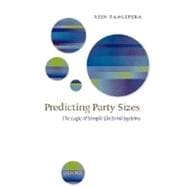
Note: Supplemental materials are not guaranteed with Rental or Used book purchases.
Purchase Benefits
What is included with this book?
| List of Figures | p. xiii |
| List of Tables | p. xv |
| List of Symbols | p. xix |
| How Electoral Systems Matter | p. 1 |
| Rules and Tools | |
| The Origins and Components of Electoral Systems | p. 13 |
| Electoral Systems-Simple and Complex | p. 23 |
| The Number and Balance of Parties | p. 47 |
| Deviation from Proportional Representation and Proportionality Profiles | p. 65 |
| Openness to Small Parties: The Micro-Mega Rule and the Seat Product | p. 83 |
| The Duvergerian Macro-Agenda: How Simple Electoral Systems Affect Party Sizes and Politics | |
| The Duvergerian Agenda | p. 101 |
| The Number of Seat-Winning Parties and the Largest Seat Share | p. 115 |
| Seat Shares of All Parties and the Effective Number of Parties | p. 143 |
| The Mean Duration of Cabinets | p. 165 |
| How to Simplify Complex Electoral Systems | p. 177 |
| Size and Politics | p. 187 |
| The Law of Minority Attrition | p. 201 |
| The Institutional Impact on Votes and Deviation from PR | p. 225 |
| Implications and Broader Agenda | |
| Thresholds of Representation and the Number of Pertinent Electoral Parties | p. 241 |
| Seat Allocation in Federal Second Chambers and the Assemblies of the European Union | p. 255 |
| What Can We Expect from Electoral Laws? | p. 269 |
| Detecting Factors Other than the Seat Product | p. 287 |
| References | p. 293 |
| Index | p. 307 |
| Table of Contents provided by Ingram. All Rights Reserved. |
The New copy of this book will include any supplemental materials advertised. Please check the title of the book to determine if it should include any access cards, study guides, lab manuals, CDs, etc.
The Used, Rental and eBook copies of this book are not guaranteed to include any supplemental materials. Typically, only the book itself is included. This is true even if the title states it includes any access cards, study guides, lab manuals, CDs, etc.